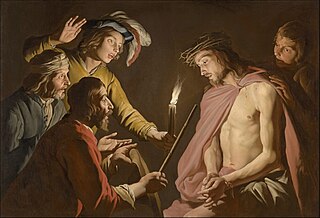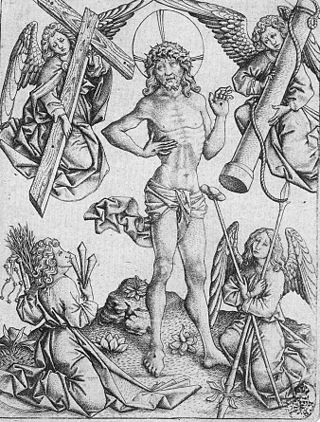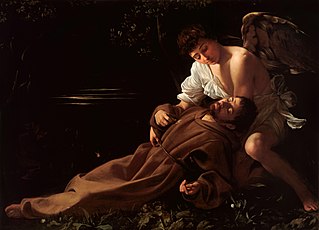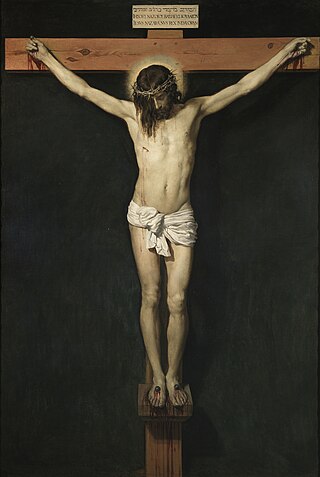
A crucifix is a cross with an image of Jesus on it, as distinct from a bare cross. The representation of Jesus himself on the cross is referred to in English as the corpus. The crucifix emphasizes Jesus' sacrifice, including his death by crucifixion, which Christians believe brought about the redemption of mankind. Most crucifixes portray Jesus on a Latin cross, rather than a Tau cross or a Coptic cross.

Crucifixion is a method of capital punishment in which the condemned is tied or nailed to a large wooden cross, beam or stake and left to hang until eventual death. It was used as a punishment by the Persians, Carthaginians, and Romans, among others. Crucifixion has been used in some countries as recently as the 21st century.

Stigmata, in Catholicism, are bodily wounds, scars and pain which appear in locations corresponding to the crucifixion wounds of Jesus Christ: the hands, wrists, feet, near the heart, the head, and back.

The Passion is the short final period before the death of Jesus, described in the four canonical gospels. It is commemorated in Christianity every year during Holy Week.
The Penitent Thief, also known as the Good Thief, Wise Thief, Grateful Thief, or Thief on the Cross, is one of two unnamed thieves in Luke's account of the crucifixion of Jesus in the New Testament. The Gospel of Luke describes him asking Jesus to "remember him" when Jesus comes into his kingdom. The other, as the impenitent thief, challenges Jesus to save himself and both of them to prove that he is the Messiah.

In Catholic tradition, the Five Holy Wounds, also known as the Five Sacred Wounds or the Five Precious Wounds, are the five piercing wounds that Jesus Christ suffered during his crucifixion. The wounds have been the focus of particular devotions, especially in the late Middle Ages, and have often been reflected in church music and art.

Arma Christi, or the Instruments of the Passion, are the objects associated with the Passion of Jesus Christ in Christian symbolism and art. They are seen as arms in the sense of heraldry, and also as the weapons Christ used to achieve his conquest over Satan. There is a group, at a maximum of about 20 items, which are frequently used in Christian art, especially in the Late Middle Ages. Typically they surround either a cross or a figure of Christ of the Man of Sorrows type, either placed around the composition, or held by angels.

The swoon hypothesis is any of a number of ideas that aim to explain the resurrection of Jesus, proposing that Jesus did not die on the cross, but merely fell unconscious ("swooned"), and was later revived in the tomb. According to the proponents of the swoon hypothesis, the appearances of the risen Jesus to his disciples following his resurrection from the dead were merely perceived to be resurrection appearances by his followers; proponents of the swoon hypothesis believe that Jesus allegedly fell unconscious ("swooned") on the cross, survived the crucifixion, and then regained enough strength to appear before them while he was still alive.

Saint Francis of Assisi in Ecstasy is a painting by the Italian Baroque master Michelangelo Merisi da Caravaggio. It is now in the Wadsworth Atheneum, Hartford, Connecticut.
The biblical account of the crucifixion, death, and resurrection of Jesus (ʿĪsā) recorded in the Christian New Testament is traditionally rejected by the major branches of Islam, but like Christians they believe that Jesus ascended to heaven and he will, according to Islamic literary sources, return before the end of time. The various sects of Islam have different views regarding this topic; traditionally, mainstream Muslims believe that Jesus was not crucified but was bodily raised up to heaven by God, while Ahmadi Muslims reject this belief and instead contend that Jesus survived the crucifixion, was taken off the cross alive and continued to preach in India until his natural death.

The Mond Crucifixion or Gavari Altarpiece is an oil on poplar panel dated to 1502–1503, making it one of the earliest works by Italian Renaissance artist Raphael, perhaps the second after the c.1499-1500 Baronci Altarpiece. It originally comprised four elements, of which three survive, now all separated: a main panel of the Crucified Christ with the Virgin Mary, Saints and Angels which was bequeathed to the National Gallery, London, by Ludwig Mond, and a three-panel predella from which one panel is lost; the two surviving panels are Eusebius of Cremona raising Three Men from the Dead with Saint Jerome's Cloak in the Museu Nacional de Arte Antiga, in Lisbon, and Saint Jerome saving Silvanus and punishing the Heretic Sabinianus in the North Carolina Museum of Art.

Christ Crucified is a 1632 painting by Diego Velázquez depicting the Crucifixion of Jesus. The work, painted in oil on canvas, measures 249 × 170 cm and is owned by the Museo del Prado.

The crucifixion of Jesus was the death of Jesus by being nailed to a cross. It occurred in 1st-century Judaea, most likely in AD 30 or AD 33. It is described in the four canonical gospels, referred to in the New Testament epistles, and later attested to by other ancient sources. Scholars nearly universally accept the historicity of Jesus's crucifixion, although there is no consensus on the details.

Crucifixions and crucifixes have appeared in the arts and popular culture from before the era of the pagan Roman Empire. The crucifixion of Jesus has been depicted in a wide range of religious art since the 4th century CE, frequently including the appearance of mournful onlookers such as the Virgin Mary, Pontius Pilate, and angels, as well as antisemitic depictions portraying Jews as responsible for Christ's death. In more modern times, crucifixion has appeared in film and television as well as in fine art, and depictions of other historical crucifixions have appeared as well as the crucifixion of Christ. Modern art and culture have also seen the rise of images of crucifixion being used to make statements unconnected with Christian iconography, or even just used for shock value.

Jehohanan was a Judean man sentenced to death by crucifixion sometime in the 1st century CE. His ossuary was found in 1968 when building contractors working in Giv'at ha-Mivtar accidentally uncovered a Jewish tomb. The stone ossuary had the Hebrew inscription of "Jehohanan the son of Hagkol".

Crucifixion in the Philippines is a devotional practice held every Good Friday, and is part of the local observance of Holy Week. Devotees or penitents called magdarame in Kapampangan willingly have themselves crucified to reenact Jesus Christ's suffering and death, while related practices include carrying wooden crosses, crawling on rough pavement, and self-flagellation. Penitents consider these acts to be mortification of the flesh, and undertake these to ask forgiveness for sins, to fulfil a panatà, or to express gratitude for favours granted. In the most famous case, Ruben Enaje drives four-inch nails into both hands and feet and then he is lifted on a wooden cross for around five minutes.

My Last Day is a 2011 Japanese-American Christian anime short film created by The Jesus Film Project, with Barry Cook and STUDIO4°C. The story unfolds through the eyes of a criminal who receives the same crucifixion sentence as Jesus Christ. This is a short film of regret, repentance and redemption. The film is available in several different languages.

Three Studies for a Crucifixion is a 1962 triptych oil painting by Francis Bacon. It was completed in March 1962 and comprises three separate canvases, each measuring 198.1 by 144.8 centimetres. The work is held by the Solomon R. Guggenheim Museum in New York.

Crucifixion is a painting of the Crucifixion of Christ, usually attributed to Perugino, with or without assistance from Luca Signorelli. The work's dating and attribution are both uncertain - Venturi and Schmarsow attribute it to a pupil of Perugino, whilst other art historians attribute it to Perugino alone or with assistance from Signorelli. The deep chiaroscuro is comparable to Signorelli's style elsewhere or to the early style of Perugino whilst he was still heavily influenced by Verrochio. The landscape background is typical of Perugino, with mountains and hills in deep perspective.

Id Nostri Cordis was a papal bull of Pope Innocent VIII promulgated in Rome on April 27, 1487, which was the 5th Kalends of May 1487 on the Julian Calendar. It was later repeated and signed again in the convent of St Laurence in June 26, 1487. The bull outlined a plenary indulgence (forgiveness) for anyone who joined the crusades against the Waldensians. His commands extended to religious and secular powers and threatened excommunication for those who did not join. A copy of the original bull was kept in the Library at Cambridge for many years and is currently held in the unpublished medieval manuscripts Ms Dd.3.25. However, Trinity College Dublin in March 2023 has since published the Waldenses Prose document Processus Contra Waldenses which contains a copy of the bull in MS 266.















